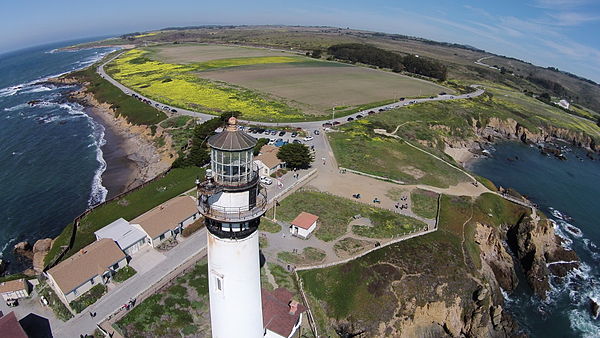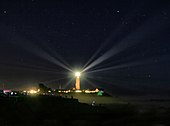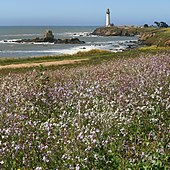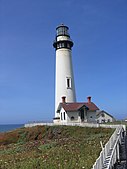fleet.wikisort.org - Lighthouse
Pigeon Point Light Station or Pigeon Point Lighthouse is a lighthouse built in 1871 to guide ships on the Pacific coast of California. It is the tallest lighthouse (tied with Point Arena Light) on the West Coast of the United States. It is still an active Coast Guard aid to navigation. Pigeon Point Light Station is located on the coastal highway (State Route 1), 5 miles (8 km) south of Pescadero, California, between Santa Cruz and San Francisco. The 115-foot (35 m), white masonry tower, resembles the typical New England structure.
 Pigeon Point Lighthouse in 2016 | |
 | |
| Location | Pigeon Point southern to San Francisco Bay California United States |
|---|---|
| Coordinates | 37°10′54.3″N 122°23′38.1″W |
| Tower | |
| Constructed | 1871 |
| Foundation | stone |
| Construction | brick tower |
| Automated | 1974 |
| Height | 115 ft (35 m) |
| Shape | tapered cylindrical tower with balcony and lantern attached to workroom |
| Markings | white tower, black trim |
| Operator | Pigeon Point Lighthouse State Historic Park[1][2] |
| Heritage | National Register of Historic Places listed place, California Historical Landmark |
| Light | |
| First lit | 1872 |
| Focal height | 148 ft (45 m) |
| Lens | First order Fresnel lens (1872), DCB-24 aerobeacon (current) |
| Range | 24 nmi (44 km; 28 mi) |
| Characteristic | Flashing white 10s, Emergency light of reduced intensity when main light is extinguished. |
U.S. National Register of Historic Places | |
| Designated | 1977 |
| Reference no. | 77000337[3] |
California Historical Landmark | |
| Designated | 1980 |
| Reference no. | 930[4] |
The lighthouse and the land around have been preserved as Pigeon Point Light Station State Historic Park, a California state park. The lighthouse is also listed on the National Register of Historic Places,[3] and designated as a California Historical Landmark.[4] The lighthouse is currently undergoing major renovations funded by the California state legislature in 2021.[5] Research published 2022 by the San Mateo County Office of Sustainability found that the lighthouse was vulnerable to erosion caused by sea level rise.[6][7]
History

Pigeon Point Lighthouse is one of the most picturesque lighthouses on the Pacific coast. The tower stands on a rocky promontory and has long been a landmark for ships approaching San Francisco Bay from the south. This headland, and hence the lighthouse, took its name from the ship Carrier Pigeon that wrecked here in 1853.
The lantern room of the tower is no longer equipped with the original first-order, 1000-watt Fresnel lens.[8] No longer illuminated for demonstration purposes,[9] the lens has 24 flash panels, is composed of 1008 hand-polished lenses and prisms and is capable of producing over 500,000 candlepower illumination. It was manufactured by the Henry-LePaute company in Paris, France, and was first lit at Pigeon Point at sunset on November 15, 1872.
Originally the tower was equipped with a lamp that burned refined lard oil (pig fat). In 1888, that lamp was replaced with a mineral oil (kerosene) lamp. To produce Pigeon Point's assigned characteristic of one white flash of light every ten seconds, the one ton lens rotated one time every four minutes. When observed from a distance, this resulted in the appearance of one white flash of light every ten seconds. The lens rotation was originally powered by a clockworks and 45 pounds (20 kg) weight. In 1926 the lighthouse was provided with electricity. Modern innovations were incorporated and the kerosene IOV lamp was replaced by a 1000 watt bulb, the clockworks by an electric motor and an electrically operated fog signal was eventually installed.
The lighthouse has been designated California Historical Landmark number 930. In 1972, the United States Coast Guard mounted a 24-inch (610 mm) aerobeacon on the front of the tower (now replaced by a smaller beacon) and officially retired the Fresnel lens from regular duty. The First order Fresnel lens is no longer lit to celebrate special occasions, such as the annual lighting of the lens, which usually occurred in mid-November (closest Saturday to November 15) the date of the original first lighting in 1872. The lens was removed from the top of the tower in November 2011, to now be displayed in the fog signal building, adjacent to the base of the lighthouse.[citation needed] The light outside the lens room, mounted on a small verandah at the top of the 100-foot (30 m) tower, rotating with six beams, is still an active aid to navigation.
The first order fresnel lens of the Pigeon Point Lighthouse originally came from the Cape Hatteras Lighthouse, which has the same lens characteristic. Following the deactivation of the original tower in 1870, the lens, which had only been installed in 1863 was removed and put into storage. Shortly thereafter in 1871 it was shipped to the west coast to be installed in the new lighthouse.[10]
Renovation
The tower has been closed to tours since December 2001 because of the collapse of brickwork supporting outside access metal walkways on the top of the structure. Cast iron was used rather than steel. Cast iron absorbs water rather than repelling it like steel, thus the walkways are severely rusted, as are the major binding ring bands at the base of the tower. The California State Park system has promised repairs, but it is estimated that even if funds were available, it would be seven to ten years before the repairs would be completed. In July, 2010, Rep. Anna G. Eshoo (D-Palo Alto) stated that of the $3.4 million she requested for her district through the Fiscal Year 2011 Interior and Environment Appropriations Act, $250,000 will be allocated to restore the upper portion of the lighthouse.[11]
In 2021, an $18 million provision was made in the California state budget for the full restoration of the lighthouse. The work is scheduled to take 18 months to complete.[5]
Contemporary uses
The restored lighthouse keepers' housing has, since the mid-1960s, also served as a youth hostel for travelers. The hostel is operated by HI USA,[12] a nonprofit organization devoted to helping the young gain a greater understanding of the world and its people through hosteling.
The Pigeon Point Lighthouse is also a logo of the E. W. Scripps Company.

Image gallery
- Pigeon Point, c. 1870s, prior to construction
- U.S. Coast Guard archive photo
- Taken circa 1950 when fully operational including the Fresnel lens and fog signal
- Pigeon Point Lighthouse with light on
- On pacific coast in summer
- Pigeon Point Lighthouse with wildflowers (view from the South)
- Pigeon Point Light Station: Inside View of the Fresnel Lens
- Pigeon Point Light Station Stairs in the Tower
- Pigeon Point Lighthouse Hostel
- Pigeon Point Lighthouse at blue hour
See also
- List of lighthouses in California
- List of lighthouses in the United States
References
- Rowlett, Russ. "Lighthouses of the United States: Northern California". The Lighthouse Directory. University of North Carolina at Chapel Hill. Retrieved 2016-06-12.
- California Historic Light Station Information & Photography United States Coast Guard. Retrieved 12 June 2016
- "National Register Information System". National Register of Historic Places. National Park Service. July 9, 2010.
- "Pigeon Point Lighthouse". Office of Historic Preservation, California State Parks. Retrieved 2012-10-14.
- "California coast: $18 million approved to restore historic Pigeon Point Lighthouse". The Mercury News. 2021-07-18. Retrieved 2022-01-19.
- staff, Curtis Driscoll Daily Journal. "Half Moon Bay faces issues due to sea level rise". San Mateo Daily Journal. Retrieved 2022-01-19.
- Howell, August. "Concerns aren't eroding as city dives in to study sea level rise". Half Moon Bay Review. Retrieved 2022-01-19.
- "Santa Cruz Sentinel - Once majestic Pigeon Point Lighthouse - a legendary landmark - now in need of major restoration". Archived from the original on 2012-04-02. Retrieved 2010-04-14.
- Nemiroff, R.; Bonnell, J., eds. (26 November 2007). "Moon Over Pigeon Point Lighthouse". Astronomy Picture of the Day. NASA.
- Duffus, Kevin (2003). The Lost Light: The Mystery of the Missing Cape Hatteras Fresnel Lens. Raleigh, NC: Looking Glass Productions. pp. 161–167. ISBN 1-888285-21-4.
- Hmbreview.com
- Hiusa.org
Further reading
- California Department of Parks and Recreation (2002). Pigeon Point Light Station State Historic Park. Sacramento, CA: California State Parks. OCLC 56543458.
- Perry, Frank (1986). The history of Pigeon Point Lighthouse. Soquel, CA: GBJ Pub. ISBN 978-0-943896-02-1.
- Perry, Frank (Spring 1999). "Legacy of the Carrier Pigeon - A History of the Pigeon Point Light Station". The Keeper's Log. United States Lighthouse Society. XV (3).
- Semones, JoAnn (2007). Shipwrecks, scalawags, and scavengers: the storied waters of Pigeon Point. Palo Alto, CA: Glencannon Press/Maritime Books. ISBN 978-1-889901-42-8.
External links
- Pigeon Point Light Station State Historic Park
- Carrier Pigeon / CINMS Shipwreck Database
- Lighthouse Friends / Pigeon Point History
- Westkueste USA: Pigeon Point Lighthouse History and description of the Pigeon Point Lighthouse with pictures (in German)
На других языках
[de] Pigeon Point Lighthouse
Das Pigeon Point Lighthouse (auch: Pigeon Point Light Station) ist ein Leuchtturm an der kalifornischen Pazifikküste. Er wurde 1871 errichtet und ist mit seinem 35 Meter hohen Turm einer der beiden höchsten Leuchttürme an der Westküste der Vereinigten Staaten.[1] Das Point Arena Lighthouse im Mendocino County verfügt über dieselbe Höhe. Der heute noch betriebene Turm steht an der Küstenstraße (California State Route 1) zwischen Santa Cruz und San Francisco. An ihm orientieren sich vom Süden in die San Francisco Bay einlaufende Schiffe. Die Gebäudeanlage, zu der mehrere Wohngebäude gehören, die heute als Jugendherberge genutzt werden, ist seit dem 8. März 1977 als Historic District im National Register of Historic Places verzeichnet.[2] Zusammen mit dem umliegenden Land bildet das Ensemble den Pigeon Point Light Station State Historic Park.- [en] Pigeon Point Lighthouse
Другой контент может иметь иную лицензию. Перед использованием материалов сайта WikiSort.org внимательно изучите правила лицензирования конкретных элементов наполнения сайта.
WikiSort.org - проект по пересортировке и дополнению контента Википедии













